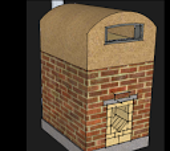Hello i hav read with a great pleasure your book, I presentely keep bees in a tropical climat in the Indian Ocean, your frame size is completely unfitted to our climat, what size of frame would you recomand for 20° lattitude?
Gallup? As brother François found suitable in 1920' Congo ?
Abbé Rueher's modified Congolese (long horizontal) beehive (Almost a Gallup frame)
found here
Bees in French Equatorial Africa: their habits, their culture
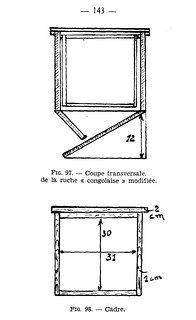
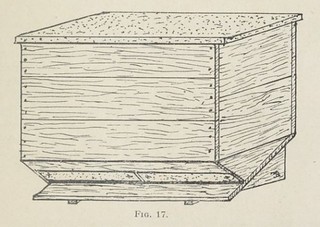 We note a distance between frames of 35mm (1920 we had not yet understood that for African bees it is between 31 and 32 mm) and that he then calls the Top bars "comb holder"
We note a distance between frames of 35mm (1920 we had not yet understood that for African bees it is between 31 and 32 mm) and that he then calls the Top bars "comb holder".
"The primitive Congolese, which dates from 1920, was modified in August 1926. The innovations made to the latter model (fig. 16) concern only the roof and the bottom. The body of the hive does not change in any way: it is placed on the tray where it is held by means of four trunnions."
"The roof is flat, made of assembled boards 15 mm. thick and covered with a sheet of zinc or sheet metal. It protrudes from the body by 2 cm. ½ on each side, which are taken up by a 2 cm. high frame. This way the tent fits over the hive, preventing access to spiders and moths."
"The bottom, instead of being flat, has the shape of an upside-down triangle, with an inner height of 12 cm., one third of the base. It increases the volume of the hive by about 12 liters. The tray, being tilted, is at the same time made self-cleaning, but remains mobile or removable."
"1° The hive always stays clean, since the flared and sloping bottom allows waste and condensation to drain away automatically."
" 2° For the bees: more space and more air. Instead of cluttering up the tray and the flight board, during rest, the workers remain in the hive and hang below the frames."
" 3° Given this particularity, an inspection or an operation is easy to do: there are, so to speak, no bees left on the combs."
" 4° The entrance, made along the whole length of the hive, gives a wide ventilation with the rear ventilation openings. Moreover, it is protected from the sun and guaranteed from the rain."
" 5° Finally, thanks to the vacuum or air chamber under the frames, the workers, - especially those of a large swarm, - form the cluster there for the elaboration of the wax intended for the construction of the combs. We have seen this, and this in itself is a very great advantage."
Excerpt from: Rueher, J.B. "The Bees of French Equatorial Africa. Their habits, their culture. Practical and easy instructions and methods for rational and modern beekeeping (1929).*»
we find a new modification for the Metropolitan adaptation in
L'Apiculteur 1932 -02
Or
here in PDF and again a description in
L'apiculteur 1931 about the colonial exhibition.
the top bars he calls them
"impropolisable "R" closing frame system"!

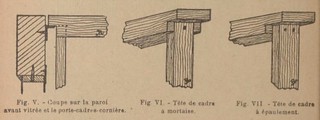

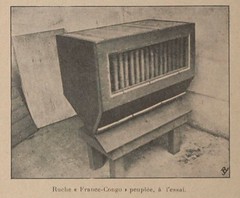
The Beehive " France Congo "
On the whole it is our "Congolese 1925", somewhat modified for the climate of Europe.
.../on the advice of beekeepers
our tropical 30x31 frame inside, which seems too small,
Our primitive frame (1920)
and when we modified it, we were unaware of the existence of the Voirnot 33x33 cm frame.
By substituting the latter for ours...
The hive body has an internal volume of 75 x 37 1/2 x 37 1/2 c/m, i.e. a capacity of 105 litres.
The front board is 80 x 20 (17 at the inner corners) x 2 1/2) c/m, notched below 10 m/m over a length of
75 c/m, which is the distance between the two short sides: this is 'the actual flight hole'.
The 80x45x2 1/2 c/m bottom thus assembled forms a vacuum or air chamber, under the frames, which, being square, do not descend into it. This chamber has a capacity of seventeen and a half litres. It ensures the bees of laplace, of the pure air unceasingly renewed, it avoids the swarming and the beard".
For "France-Congo" we'll use 36mm wide closing frames.















